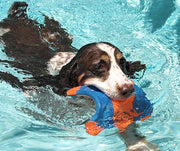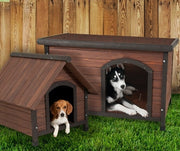My Pet Destroyed My Stuff!

Why is your pet being destructive and what can you do about it?
Bringing home a new pet is always an exciting time. You introduce him to the family, the house, and maybe even his new yard. You show him his bed and his toys. And then, the inevitable happens. Your new pet will destroy something. He will destroy something you probably really like. It is what pets do. Why do pets do this and, more importantly, how can you stop them?
WHAT ARE TYPES OF DESTRUCTIVE BEHAVIOR?
Destructive dog or cat behavior can take on many forms. The most common examples for dogs are chewing and digging; for cats, it's scratching and destroying furniture and houseplants. Your dog may chew on anything, from toilet paper or a sneaker to your furniture or even your house itself. He may dig up your flower bushes or dig under your fence. Your cats may scratch up your sofa, your drapes, or your carpet. Another form of destructive behavior is excessive licking of furniture, rugs, or themselves. Finally, if your pet, who is otherwise litter- or house-trained, starts using the bathroom all over the house, that may be a sign of a larger problem.1
WHY IS MY PET BEING DESTRUCTIVE?
First of all, your pet is not being destructive, rude or spiteful. There is generally a very reasonable explanation for his bad behavior. Determining the cause of your pet's bad behavior will go a long way in figuring out how to curb it.
If you have a puppy who is constantly chewing on things, he may be teething. When his teeth are coming in, chewing alleviates some of the pain. Destructive behavior is also a common symptom of boredom. Does he have enough active time with you, does he have toys or social entertainment? Having an arsenal of heavy-duty dog chew toys on hand can divert your dog's chewing instincts from your furniture to his toys. Similarly, he may be behaving poorly because it is a surefire way to get attention. For your pets, negative attention is better than no attention at all, so they act out to get their owners to interact with them.
Another cause of destructive behavior is dog or cat anxiety. Many pets, especially those who have been rescued from a shelter, suffer from separation anxiety. This should not discourage anyone from adopting from a shelter, as these animals are often smart, loyal, and undyingly sweet. Separation anxiety can be treated and overcome. Your pet may have anxiety caused by outside forces like thunderstorms or fireworks. When your pet gets freaked out, he often communicates that by digging, scratching, or chewing.
Your pet may also just be utilizing his instincts. If the pet is new to your family, he may simply be investigating his new space. Dogs often investigate with their paws and mouths, getting into things to see what they're all about. Your pet could be tracking something. If your pet is hunting a bug or rodent, he will stop at almost nothing until he catches his prey, digging, scratching, and chewing at what stands between them. Another culprit behind destructive behavior may be as simple as a change in his feeding schedule. If your pet is expecting dinner at 5, and it's 7, he may start digging around for some grub. Animals are very structured, so maintaining a strict schedule can greatly reduce destructive behavior.2
HOW CAN I SAVE MY STUFF?
Getting your pet to stop destroying things in your home, or even damaging your home itself, takes a two-pronged approach. As the old adage says, an ounce of prevention is worth a pound of cure. Preventing bad behavior is a lot easier than correcting it. If your dog tends to chew shoes or socks, limiting his access to those items can cut down on his chances of destroying them. Limiting your pet's access to certain areas when you're not home can go a long way in preventing destruction. Crates and kennels can be used as a positive training tool when housebreaking a puppy and can eventually become a den where your dog feels at home. When used effectively, the crate should be a place where your pup is comfortable and feels safe rather than a punishment. No matter which breed you have, we offer a large selection of wire dog crates in all sizes so you can ensure your dog has a comfortable, den-like retreat. Another amazing way to prevent destructive behavior is to make sure your pet gets plenty of proper exercise.3 A pooped pet is not a destructive pet.
Correcting destructive behavior takes time and patience. If your dog or cat is chewing on something he shouldn't be, gently correct him and then give him an alternative. There are plenty of pet accessories online that your pup will have a better time chewing instead of shoes and furniture. You should be playing tug-o-war with your dog with a tug toy instead of your favorite sneakers. Offer him a chew toy or treat toy, and then praise him for playing with it. With enough repetition and consistency, your pet will learn what is OK to chew on and what is not. If your cat is scratching, an obvious alternative is a scratching post. Find a scratching post that mimics the texture of what your cat likes to scratch. Another way to correct destructive behavior is through repellant spray. Spraying things that your pets shouldn't be playing with will let them know that the item is off limits. Then, again, offer them a positive alternative.
If your pet's destructive behavior is anxiety-based, it takes a bit more effort to stop. Separation anxiety takes a specific set of steps to overcome, but it can be done with enough care and patience. If your pet gets nervous by loud or sudden noises, one of the first things you should do is create a safe place for him to hide. It should be small, dark, and away from the noise, like his crate if he has been crate trained. If none of these are effective, speak to your vet about possible medications or other treatment options.4
Having your pet destroy something is just part of the adventure of owning a pet. Think of it as the cost of doing business. It does not mean, however, that it has to be a permanent part of your and your pet's relationship. Learning why your pet is being destructive can help you figure out how to prevent it and eventually overcome it. Then, maybe you can keep your favorite pair of shoes in one piece.
Sources:
- Destructive Behavior in Dogs. petMD. Web. 09 March 2015.
- Hetts, Suzanne. Destructive Behavior in Dogs. Animal Humane Society. Web. 10 March 2015.
- How to stop dogs from destructive chewing. DogTime, 15 May 2009. Web. 10 March 2015.
- Fear of Thunder and Other Loud Noises. The Humane Society of the United States, 29 July 2014. Web. 17 March 2015.
Previous article

Next article

Related posts
View all-

Keep Your Pets Safe During the Holidays
The holiday season brings joy, festivities, and a break from the usual routine. While you're enjoying the celebrations, it's important to remember that the holidays can present unique challenges for our furry family members. The new sights, sounds, and people can be overwhelming, and common festive items can pose unexpected risks.
Read Article -

Holiday Gifts for Every Pet Personality: The Ultimate Guide
The holiday season is finally here, and for many of us, that means finding the perfect presents for the ones we love most—our pets. Whether they are a steadfast dog who never leaves your side or an independent cat who graces you with their presence on their own terms, our pets are cherished members of the family. They deserve to celebrate right alongside us, stocking stuffers and all.
Read Article -

How to Keep Your Pet Calm During Thanksgiving
Thanksgiving is a time for family, friends, and food, but for our pets, the holiday can be overwhelming. The sudden change in routine, unfamiliar faces and scents, and increased noise can trigger significant stress. Understanding why your pet might feel anxious is the first step toward creating a peaceful holiday experience for everyone, including your furry family members. This guide offers calming tips for pets and practical solutions to ensure your dog or cat feels safe and secure during the festivities.
Read Article



